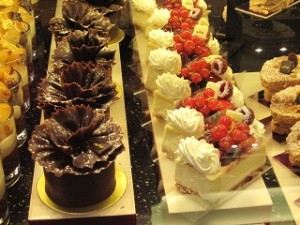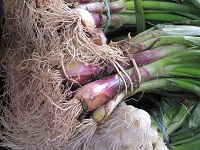Walking up to the Cordon Bleu, I was feeling a little nervous. A little edgy. I wonder if Julia Child felt like this the first time she entered these hallowed halls. Who am I kidding? I don’t think she ever felt nervous.
There are only eighteen of us in this year’s course, the eighth class in the “ Diplome Universitaire de Gout, de la Gastronomie et des Arts de la Table”. There are students from Hong Kong, Malaysia, Columbia, Australia, Brazil, UK, France, USA – and two of us from Canada. (“Oh – you’re both from Canada? Did you know each other before this?” “Yes, we did actually, because there are only, like, 100 people living in Canada.”) Backgrounds are pretty varied, a few chefs, some wine folks and a few people whose field of work is not food related, but have a serious passion for food and wine. Everyone seems a little apprehensive. And very quiet…..
The morning’s class is all about the Physiology of taste. It is delivered by a gentleman who has spent his fifty year career studying taste. He does research at the Institut Francais du Gout. I wonder if Canada has an Institute dedicated to the study of how humans taste food? I learn way more about the human brain, neurons, and the Human Genome than I ever thought possible. We all taste differently, and we each have 10,000 nerve fibres and approximately 100 genes dedicated to taste. Taste buds do not “die” as I had previously heard rumoured, in fact, every ten days the “papilles” which communicate taste to the brain regenerate. Children don’t have heightened taste ability; they just completely lack the social skills to be polite about what they hate. Teeth play a yet to be determined role in tasting – those with false teeth taste less. You get the idea. It’s heavy going, but to me fascinating, and I take nine pages of notes. I even take it all in completely in French.

After an incredibly civilised lunch (pork cheeks, puree de pommes de terre, and clafouti, with a little wine of course), we hear from a Psychologist from the University of Paris. Her speciality is Children’s Food Behaviours – she quickly advises – not pathological children, normal children. (What are these “normal” children she speaks of?) Babies naturally like what they need to survive (milk) and naturally start and stop eating according to what their body needs. Young children (ages 2-6) also like what their body needs – calorie dense foods, but start to be influenced by parents and caregivers when to eat and how much. “Finish what is on your plate!” This stopping of self-regulating is a real problem. When “petit l’homme” (little man) no longer understands what hungry means – this is when “petit l’homme” does not stay so “petit”.
The opposite is also true – restricting food intake actually increases the amount of food a child wants. Here’s an interesting study: Two groups of eight year olds were shown a plate with red and yellow M&M’s. (Couldn’t have been France) One group was allowed to eat as much as they wanted. The other group was not allowed to eat the red ones. The next week, all the children were allowed to eat as much as they wanted, and every single child who had been restricted the week before ate much more than the other children who had not.
This notion of neither limiting nor “prescribing” foods is a movement in France right now called “Le Gros”. According to this theory (which, if it is a “diet” plan by my accounts should be called “Le Mince”) there are no good or bad foods, it’s all about the quantity. You can eat and drink whatever you want – chocolate very day – all in moderation. You’ve got to love the French.
Apparently, kids have to be “taught” how to like vegetables. The professor tells us that when we learned how to drive cars, we did not go straight out onto the highway. We had to take it slowly. We learn it’s the same for vegetables. Go slowly. A little béchamel and some gruyere go a long way to “teaching” them how to like vegetables. (What doesn’t taste good with a little béchamel and Gruyere??) Children need to be introduced to things constantly, they need to be encouraged to try just a bite, and with time they will “learn” to like new things. Kids also need to see their parent trying new things. Removing selection only makes things worse.
After all the classes, and over a few bottles of wine and a little cheese (in moderation of course), some of us recapped the day.
It was long.
It was tiring.
Our brains were full of new knowledge.
And each of us are thrilled to be at the esteemed Cordon Bleu in Paris, spending fourteen days learning about the fascinating world of food and wine.
